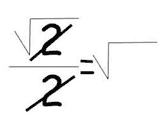2.30258509299405
The Computing Wonder
What is a Logarithm?
A logarithm is just an operation like addition or multiplication. It undoes exponents, in much the same way that division undoes multiplication.
So, a logarithm is written as logab, where a and b are just numbers, and a is called the base. What this means, is that if logab=x, we are asking what x makes ax=b. So, for example, log28 asks what number x makes 2x=8? Since 23=8, log28=3.
Common Logarithms
The common logarithm is a special log with base 10. Since it is used so often, when you write just logb without a base, we assume the base to be 10, in much the same was that we assume the radical sign √ with no number to mean the square root, and not any other root. So, for example, log1000= 3 because 103=1000.
Connecting to the Natural Log
A natural log is just a logarithm that has the exponential constant e as a base. Suppose we have a common log of a number and we want to convert that to the natural log instead. Changing bases is not actually all that complicated! All we need the connection factor 1/loge.
ln b * log e = log b
Going the other way is just as easy. To convert from the natural log to a common log, we just multiply by that same factor loge instead of dividing.
log b* 1/log e = ln b




